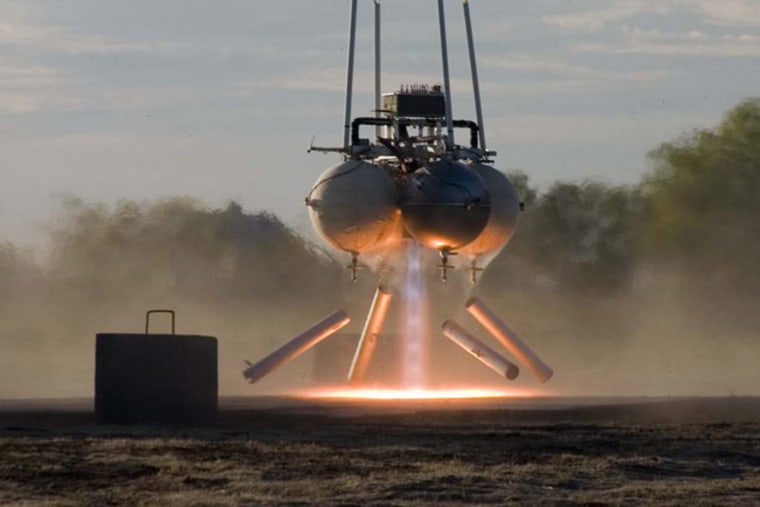Ten teams are gearing up for a fall competition to present a vehicle of their own design that can simulate trips between the moon's surface and lunar orbit.
The 10 teams were announced today by the X Prize Foundation, which is hosting the 2008 Northrop Grumman Lunar Lander Challenge. The contest is planned to take place at Holloman Air Force Base in Alamogordo, N.M., Oct. 24-25, 2008.
A $2 million cash prize awaits the team that successfully complete two challenges involving taking off and landing on a simulated lunar surface. The purse is provided by the NASA Centennial Challenges Program, in an effort to encourage commercial research into moon landing technology. The contest is also funded by the New Mexico Spaceport Authority and the State of New Mexico.
The first stage of the competition requires a vehicle to take off from a designated launch area, rocket up to 150 feet (50 meters) in altitude, then hover for 90 seconds before landing precisely on a pad 50 meters away. The flight must then be repeated in reverse. In order to pass, the entire two-trip journey must be completed within two and half hours.
And Level 2 is even harder. During this stage the rocket must hover for twice as long in the air before landing precisely on a simulated lunar surface, packed with craters and boulders to mimic real moon terrain. The hover time in the Level 2 test was calculated to closely simulate the power needed to perform a real lunar mission.
Though nine competitors signed up to compete in last year's competition, held as part of the X Prize Cup, only one team, Armadillo Aerospace, was prepared to take on the challenge. That vehicle missed passing Level 1 by seven seconds, and ultimately burst into flames.
This year's cache of competitors is hoping things go better this year. The X Prize Foundation also has faith someone will successfully complete the mission.
"Once again, we have excellent teams prepared to compete in the Northrop Grumman Lunar Lander Challenge," said Peter H. Diamandis, chairman and CEO of the X Prize Foundation. "We are excited to see new teams join the competition, and I am confident that we will give away prize money this year."
This year's teams will include:
Armadillo Aerospace: Based in Mesquite, Texas, and led by 3D graphics pioneer and video game developer John Carmack, the team was the only one to fly a vehicle at the 2006 and 2007 competitions. The group is also building rocket plane engines for the Rocket Racing League.
BonNova: Led by Allen Newcomb and based in Tarzana, Calif., BonNova was established for the sole purpose of winning the Lunar Lander Challenge. Newcomb designed all of the avionics, flight software, and ground software for SpaceDev's hybrid rocket engine on Burt Rutan's SpaceShipOne, the winner of the Ansari X Prize.
Paragon Labs: The team is led by Kevin Sagis, a veteran of Lockheed Martin, and headquartered in Denver, Colo. The groups, composed of industry professionals from various disciplines, intends to compete in Level 1 only.
Phoenicia: This group, headquartered in Emeryville, Calif., is led by William Baird. Their Level Two vehicle is called The Wind at Dawn.
TrueZer0: TrueZer0 is a four person team led by Todd Squires and Scott Zeeb and based in Chicago, Ill. The team consists of a mechanical engineer, an electrical/CS engineer, and a father and son who own and operate a machine shop. The team plans to compete in Level 1 with its vehicle, Ignignokt.
Unreasonable Rocket: This group is a father and son team located in Solana Beach, Calif., with a long-term goal of showing that significant rocket and space flight capabilities are achievable by small teams. Their vehicles are called Burning Splinter 90 and Burning Splinter 180.
Four other teams have requested to remain confidential. The X Prize Foundation will announce their names 60 days before the start of the competition.
